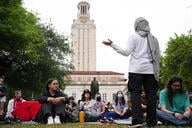You have /5 articles left.
Sign up for a free account or log in.

Istockphoto.com/erhui1979
A guided meditation on the word “empathy.” An ambidextrous drawing where a student used both hands to illustrate and write about the word “renaissance.” A video on the word “ingenuity” where the student spoke the entire final paper into Siri without typing. A violin background score with birds flying into the sky to explain the word “unknowable.”
These are examples of student final projects in an M.B.A. class titled Creative Thinking: Designing Sustainable Innovations that I taught in Rome and where we used principles of Leonardo da Vinci to understand the creative process. Many students in this class were specializing in finance, accounting, supply chain and other “hard” disciplines, and some were pursuing joint J.D. degrees. Thus, this was probably the first time in their careers that they had worked on a nontraditional final project.
As an educator in a business school, one of my deep concerns is that, despite an increasing emphasis on creativity and innovation in the business world, we do not emphasize this enough in our M.B.A. programs. In fact, to the contrary, our programs as whole tend to kill creativity as a result of the way we recruit students, structure classrooms and teach classes, and grade. My endeavor was to change the way we teach students so that we can give students an opportunity to tap into their creative potential and address real-world problems with sustainable and creative solutions.
The prescribed textbook for the class was How to Think Like Leonardo da Vinci. Thanks to our school’s international business center, the Ahlers Center for International Business, we were able to use the city of Rome to understand the nature of creativity instead of conducting regular company visits. We toured an opera house, Cinecittà Studios and LUISS University’s incubator to understand how creativity presents itself in an opera or a film performance as compared to an incubation center. We also had students make a film about their Rome experiences and visited the Leonardo da Vinci museum to learn some of the secrets to his creativity.
The final exam was the biggest challenge. It was based on an idea that I had borrowed from Oxford University: the “All Souls Fellow Exam.” Considered one of the most difficult exams, it is impossible to study for and is a one-word essay question. Following that format, I picked words from our class discussion that were relevant to our understanding of creativity and the creative process. Those included words such as "renaissance," "unknowable," "empathy" and "ingenuity," along with Leonardo’s principles such as dimostrazione (demonstration), curiosità (curiosity), sfumato (smoke) and others. Students selected their words randomly from a bowl.
But I made it a little different from the Oxford exam. Instead of asking students to write about the word, I tasked them to come up with a creative output that used the learnings in class -- which could be a written paper or anything else. Given that some of the international students did not have writing or speaking capabilities similar to native English speakers, it was a take-home exam. Students had two days to work on and deliver the final output. They were free to reach out to anyone they wanted for ideas, including each other, but they could not plagiarize. They were also allowed to talk to each other to brainstorm ideas, but they needed to come up with their own, individual response.
To say this was a challenge for many students, who were used to specific instructions and more clarity on the desired final output, is an understatement. They were familiar with analyzing financial statements and profit and loss accounts; they knew the basics of forecasting, interpersonal relationships, strategy concepts and marketing research. But they had never had to face a take-home exam where the process was ambiguous and the outcome was unknown and scary.
Having done research on innovation and creativity over the past 15 years, I knew that the biggest killer of creativity is risk taking. Most of my students were used to getting As in class. Therefore, to them, getting a B or worse was a big risk that could jeopardize their subsequent job placements. So I did one thing that was controversial by academic standards: I said that they were guaranteed a B on the final.
Why? Because I strongly believe that as instructors we must shift risk from our students to ourselves. I told them they were in the city of Rome, and if they chose to go sightseeing and give me a minimal output where they wrote a few pages on the topic, they were guaranteed a B.
I knew I’d certainly be in trouble with my university and the graduate office for guaranteeing a grade if students decided to produce deliverables that were not up to our standards. But this was the one chance for them to be at their creative best and experience the best that they could do with minimal risk. I also told them that I expected them to not let me down.
One thing I did to minimize a little bit of risk for myself was to set up a peer feedback mechanism. On the last day of class, each student would discuss their work and receive comments from their peers. Given that the students were in a cohort, I expected that peer pressure to perform and competition with one another would keep them on track.
When I handed out the final exam, I did not tell the students that it was based on one of the toughest ones in the world. I also told the more nervous students that approached me that if their final output did not merit a B, I would ask them to rework it until they received an 80 percent. (I capped it at 80 percent to be fair to other students who delivered their best work the first time.) But that did not happen, because every student outperformed my expectations and no rework was involved.
In fact, the results far exceeded my expectations. Every student came up with a different output and a distinct approach to the topic and the format. And, most important, they all tapped into their inner creative potential. Student feedback indicated that this was one of the few classes where they pushed themselves to deliver their best to the world.
This class experiment raised several interesting questions for me that may be relevant to other educators in many disciplines and especially those in business. First, while we train students with critical thinking and analytic skills to deal with programmable questions, do we train them to deal with the unknowable ones that are becoming increasingly relevant in the real world? Second, are we shifting enough risk from students to ourselves so that they can deliver their best output? And, finally, what are some other mechanisms by which we can minimize risks for our students to tap into their creative best?




